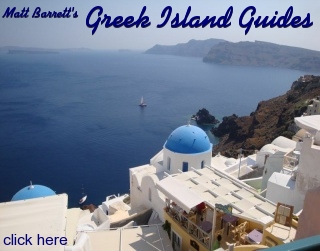| This last few years have brought great changes to downtown Athens as the city has become a top destination for travelers. Areas like Omonia Square and Platia Kotzia which were once the center of Greek tourism but avoided in the recent past, have been cleaned up with new hotels opening up to handle the overflow from the hotels closer to the Acropolis and the commercial center. |
Platia Kotzia
|
|
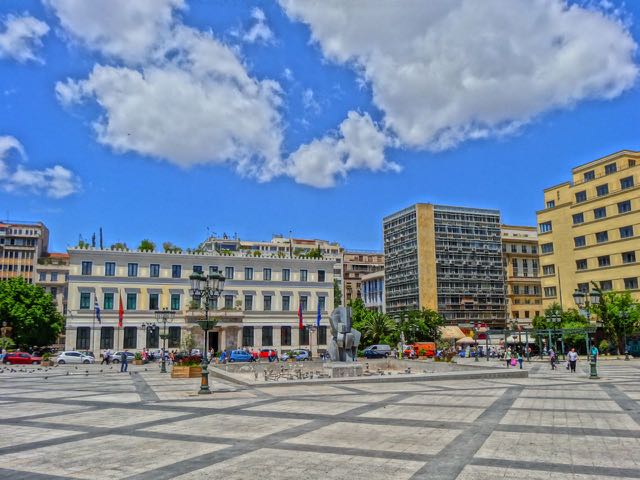 Beyond the
Athens Market on Athinas
street is the Platia of the Dimarcheo, or City Hall
Square, the government center for Athens. The square,
which is known as Platia Ethniki Andistassis (National
Resistance) or more popularly Kotzia Square until a few years ago was a total disaster. When
they were building a parking lot they discovered
antiquities. The archaeologists rushed in, excavated
it and then left it for years as a giant fenced in pit
for people to throw their garbage in. But now it has
been covered up and is one of the most impressive
squares in Greece, surrounded by some beautiful
neo-classic buildings from the turn of the
century. In
the early days of travel to Greece this platia
was the tourism center with all the tourist shops
which gradually moved to Monastiraki and then to
Plaka. Though the marble Panathenaic Stadium usually gets the credit for being the site of the first modern Olympic games in 1896, the first revival of the ancient Olympic games actually took place in Platia Kotzia in 1859.
Beyond the
Athens Market on Athinas
street is the Platia of the Dimarcheo, or City Hall
Square, the government center for Athens. The square,
which is known as Platia Ethniki Andistassis (National
Resistance) or more popularly Kotzia Square until a few years ago was a total disaster. When
they were building a parking lot they discovered
antiquities. The archaeologists rushed in, excavated
it and then left it for years as a giant fenced in pit
for people to throw their garbage in. But now it has
been covered up and is one of the most impressive
squares in Greece, surrounded by some beautiful
neo-classic buildings from the turn of the
century. In
the early days of travel to Greece this platia
was the tourism center with all the tourist shops
which gradually moved to Monastiraki and then to
Plaka. Though the marble Panathenaic Stadium usually gets the credit for being the site of the first modern Olympic games in 1896, the first revival of the ancient Olympic games actually took place in Platia Kotzia in 1859.
|
|
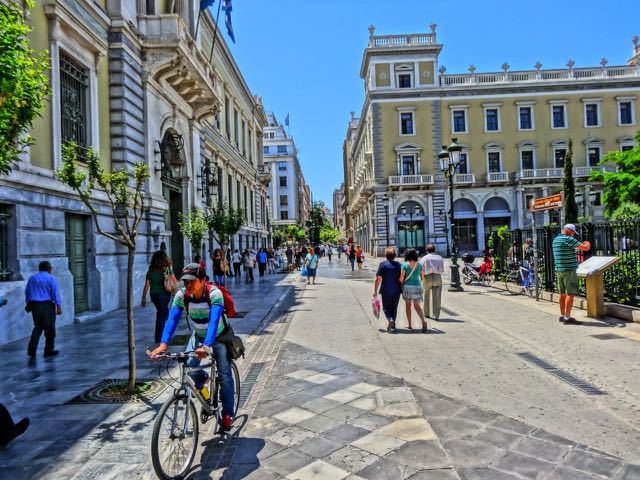 In the nineties the square unfortunately
became a hangout for drug dealers and junkies
at night and the area got a bad reputation. But it was always perfectly safe by day
since it is in the primary shopping area of Athens
and now that they have moved all the undesirables to
the area by the train station Platia Kotzia can be visited at any time. Be sure
to check out the sculptures on display here and
the pet store with the exotic parrots and toucans.
There are a couple great cafes on the square,
especially the one next to the pet store where you
can buy a cheese pie and spend hours being
entertained by the pigeons who fight each other
for it. Across the square from the pet store are a
couple classic cafeneons just on the other side of
the ruins. The impressive National Bank of Greece on the bottom (or maybe its the top) of the square is on AAeolou Street, one of Athens popular pedestrian shopping streets, which leads you right back past the Central Market and all the way to Monastiraki and the Plaka.
In the nineties the square unfortunately
became a hangout for drug dealers and junkies
at night and the area got a bad reputation. But it was always perfectly safe by day
since it is in the primary shopping area of Athens
and now that they have moved all the undesirables to
the area by the train station Platia Kotzia can be visited at any time. Be sure
to check out the sculptures on display here and
the pet store with the exotic parrots and toucans.
There are a couple great cafes on the square,
especially the one next to the pet store where you
can buy a cheese pie and spend hours being
entertained by the pigeons who fight each other
for it. Across the square from the pet store are a
couple classic cafeneons just on the other side of
the ruins. The impressive National Bank of Greece on the bottom (or maybe its the top) of the square is on AAeolou Street, one of Athens popular pedestrian shopping streets, which leads you right back past the Central Market and all the way to Monastiraki and the Plaka.
If you go another block on Athinas street or AAeolou Street you come to Lamvropoulos, a 6 floor department store and a
good place to hang out if you want to shop in the
summer and not leave air-conditioning. There
is a nice little cafe-restaurant on the top floor.
Hotels Near Platia Kotzia
The Greotel Pallas Athena which is right on Athinas Street is a 4-star hotel that has double rooms for under 100 euros. The 2-star Economy Hotel is a
block off Athinas and is what its name imlpies, an economy
hotel, though the back streets behind the city market can be a little seedy at night so you may be happier a few blocks down at the Hotel Attalos and pay not much more to be in a friendlier area closer to the sites or split the difference and stay at the Hotel
Cecil which is a little cheaper. Also nearby is the modern 4-star Hotel Fresh which was good enough for Jamie Oliver to stay at and film a segment of his show on the roof where he grilled souvlakia
next to the pool.
|
Omonia Square
|
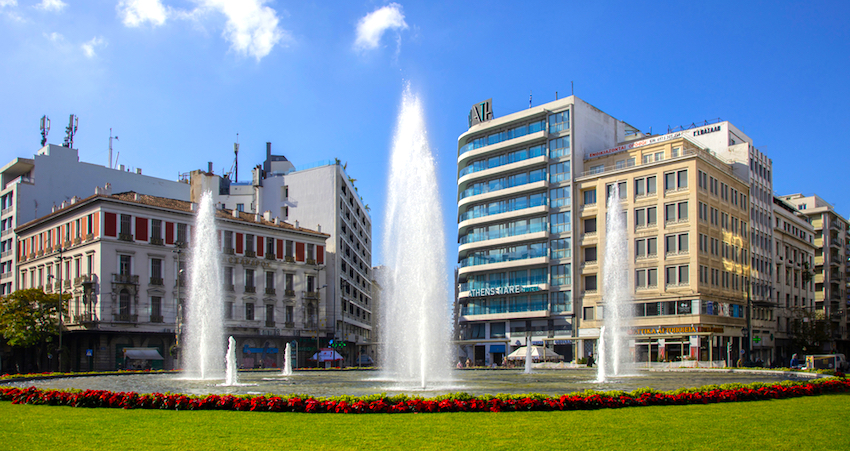 |
|
If you continue down Athinas street from the
Central Market, you will come to Omonia square,
Athens oldest. It's worth a trip though whether or not you visit Omonia is not going to make or break your holiday and families with small children may want to stay closer to the Plaka and the Acropolis if for no other reason you won't have to walk as much. But I have Athenian friends who won't come
here after dark because for the last 20 years or so it has been an area that you might label as undesirable if you are bothered by things like drug addicts, homeless and hungry refugees, and people who were there because they had nowhere else to go.
But in 2020 the square was completely redone from the last mess of a design, and now has a fountain, like in the old days. And the neighborhood is being cleaned up as hotels are renovated to handle the overflow from the more desirable locations around the Acropolis.
|
|
Omonia square is surrounded with fast-food restaurants and cafes. The
pedestrian streets on the north side of the square
are interesting in a third-world kind of way.
There are several major hotels right on the square that have been
bought up by big hotel companies and renovated.
Beneath the square is the metro. There is a health food store on Panepistimiou-Venizelos Street just off the square. Directly opposite Agios Konstantinou Street passes the National Theater and ends at Kariaskakis and Metaxourgiou Square. If you continue down Theodorou Diligiani Street you will come to the Larissa Station where you get the trains to northern Greece or the buses to Albania. Its not the best area though there are a number of nice hotels that do much of their business with foreign travel
agents and automated-booking sites from people who can't resist the low prices. So lets head back to Omonia.
|
|
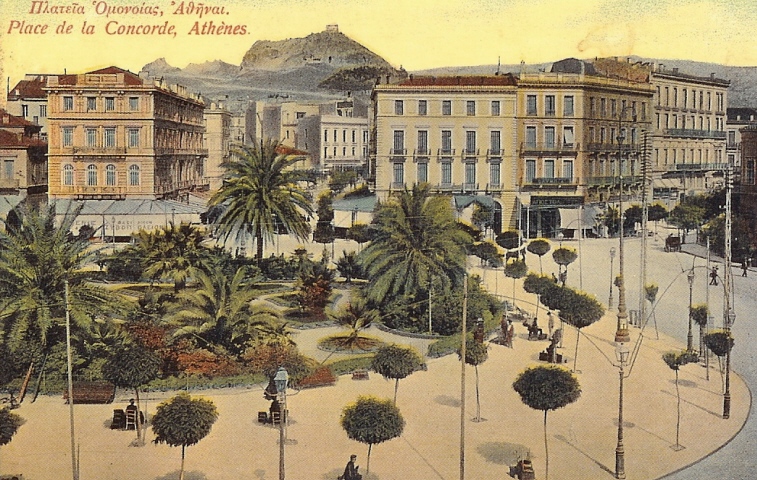 Omonia
square was at one time quite beautiful and a
centerpiece for the city. If you go downstairs
into the metro station you can see old photos of
it in the glory days. When Athens embraced the
automobile, Omonia was one of the major casualties
and the square became less people friendly and
eventually it was not even automobile friendly as
cars converged on it from all directions. They
have been trying to recapture the bygone days and
have rebuilt the square several times in the last
few years either to 'get it right' or to
make sure a construction company owner or
city official does not go to bed hungry. The
previous version of Omonia Square was a mystery.
First of all nobody knew if it was finished or
not after they unveiled it. (That gives you an idea of the architecture).
They wanted to ask the people who designed it but
apparently they couldn't be found. I personally would
have loved to see a few more trees so it would
slightly resemble the old photos but there
were none. It was only after people complained that Omonia Square looked like Eastern Europe during the cold war that the city relented and planted a few olive trees in giant pots.
Omonia
square was at one time quite beautiful and a
centerpiece for the city. If you go downstairs
into the metro station you can see old photos of
it in the glory days. When Athens embraced the
automobile, Omonia was one of the major casualties
and the square became less people friendly and
eventually it was not even automobile friendly as
cars converged on it from all directions. They
have been trying to recapture the bygone days and
have rebuilt the square several times in the last
few years either to 'get it right' or to
make sure a construction company owner or
city official does not go to bed hungry. The
previous version of Omonia Square was a mystery.
First of all nobody knew if it was finished or
not after they unveiled it. (That gives you an idea of the architecture).
They wanted to ask the people who designed it but
apparently they couldn't be found. I personally would
have loved to see a few more trees so it would
slightly resemble the old photos but there
were none. It was only after people complained that Omonia Square looked like Eastern Europe during the cold war that the city relented and planted a few olive trees in giant pots.
Anyway they are back at square one with a fountain and grass and flowers and we will have to see how the square develops. Hopefully someone will look at the old postcards and make it more people friendly.
|
|
Little London
A block from
Omonia in a feat of engineering skill that will be
studied in city planning departments in
Universities all over the world the traffic
planners have actually managed to have one street
where traffic is reversed. On the small street
that connects Aeolou and 28th of October street
between Stadiou and Panapistimiou the lanes are
reversed so it is as if you are driving in
England. This is not mentioned so you can visit it
as a tourist attraction but so that you won't get
run over when crossing the street because you were
looking the wrong way (the right way
actually). |
Hotels Near Omonia Square
 You can get a lot of hotel for the money if you want to stay in the triangle between Omonia, Kariaskaki Square and the Larissa Train Station. 4 and 5 star horels can cost what you would pay for a 2 star hotel in the Plaka, though as more tourists choose Greece I am
guessing the prices will rise, if they haven't already. On booking sites some of the hotels lose points because of location but in general they can be well run and clean and just a few steps from the Metaxougeio or Omonia Square Metro. The Athens Tiare Hotel is a 4 star hotel overlooking Omonia Square. The Elikon is an
historical hotel just off the square on one of the pedestrian streets, that is clean, comfortable and cheap. The Polis Grand and the Melia Hotel are good 4 star hotels just north of Omonia on Patission Street. Both have restaurants and views of the Acropolis and the Melia has a pool. The Hotel Titania is a couple blocks up Panapistimiou Street and is a popular 4-star hotel also with a rooftop restaurant. There are loads of 2 and 3 star hotels in the area which you can find in Matt's Budget Hotel page or by Searching Omonia Square Hotels. You can find even cheaper 2-star hotels by searching Metaxourgio Hotels if cheap is more important to you than convenience and surroundings. Staying at a cheap hotel is no bargain if someone steals your wallet, credit cards, camera on the way from the metro to the hotel though these areas have been somewhat cleaned up and you are just as likely to be pickpocketed on the Acropolis or on the metro than in these neighborhoods. You can get a lot of hotel for the money if you want to stay in the triangle between Omonia, Kariaskaki Square and the Larissa Train Station. 4 and 5 star horels can cost what you would pay for a 2 star hotel in the Plaka, though as more tourists choose Greece I am
guessing the prices will rise, if they haven't already. On booking sites some of the hotels lose points because of location but in general they can be well run and clean and just a few steps from the Metaxougeio or Omonia Square Metro. The Athens Tiare Hotel is a 4 star hotel overlooking Omonia Square. The Elikon is an
historical hotel just off the square on one of the pedestrian streets, that is clean, comfortable and cheap. The Polis Grand and the Melia Hotel are good 4 star hotels just north of Omonia on Patission Street. Both have restaurants and views of the Acropolis and the Melia has a pool. The Hotel Titania is a couple blocks up Panapistimiou Street and is a popular 4-star hotel also with a rooftop restaurant. There are loads of 2 and 3 star hotels in the area which you can find in Matt's Budget Hotel page or by Searching Omonia Square Hotels. You can find even cheaper 2-star hotels by searching Metaxourgio Hotels if cheap is more important to you than convenience and surroundings. Staying at a cheap hotel is no bargain if someone steals your wallet, credit cards, camera on the way from the metro to the hotel though these areas have been somewhat cleaned up and you are just as likely to be pickpocketed on the Acropolis or on the metro than in these neighborhoods.
If I am scaring you out of staying here you can see the areas I recommend on my Hotels page.
|
The Polytechnic and Nov 17th |
|
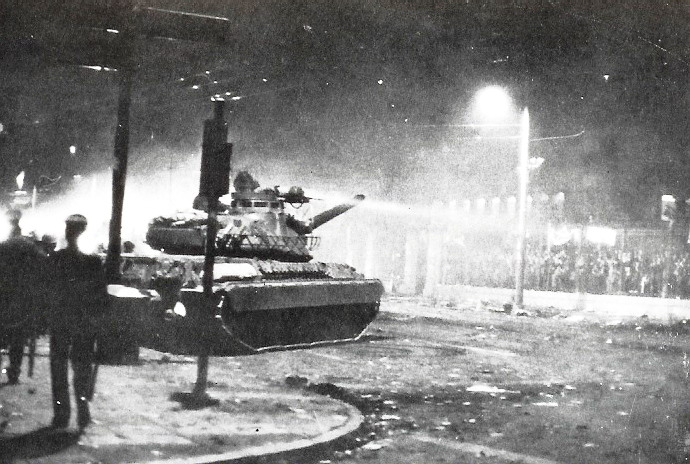 If you come from Omonia take a right on Panipistimiou and your
first left you can walk a few blocks up 28th of
October street and be at the Athens Polytechnic
University where the demonstrations of Nov 17th
1973 eventually brought about the fall of the
Dictatorship. (Only to be replaced by a worse one. The students barricaded themselves
inside the University and broadcast on a
clandestine radio for their fellow Greeks to rise
up and overthrow the government. They were joined
by many and for 2 weeks the country looked
like it might break into revolution but finally
the army was called in. On the night of Nov
17th a tank burst through the gate and many
students were killed. The gate has remained locked
since then. Though not a popular tourist
destination it is a symbol of resistance. Every
year on the anniversary a march begins here
and goes to the US Embassy which supported the
dictatorship, led by the mothers of the students
who died, dressed in black. See my section on Rebellion in my
History
of Greece.
If you come from Omonia take a right on Panipistimiou and your
first left you can walk a few blocks up 28th of
October street and be at the Athens Polytechnic
University where the demonstrations of Nov 17th
1973 eventually brought about the fall of the
Dictatorship. (Only to be replaced by a worse one. The students barricaded themselves
inside the University and broadcast on a
clandestine radio for their fellow Greeks to rise
up and overthrow the government. They were joined
by many and for 2 weeks the country looked
like it might break into revolution but finally
the army was called in. On the night of Nov
17th a tank burst through the gate and many
students were killed. The gate has remained locked
since then. Though not a popular tourist
destination it is a symbol of resistance. Every
year on the anniversary a march begins here
and goes to the US Embassy which supported the
dictatorship, led by the mothers of the students
who died, dressed in black. See my section on Rebellion in my
History
of Greece. |
Exarchia
|
|
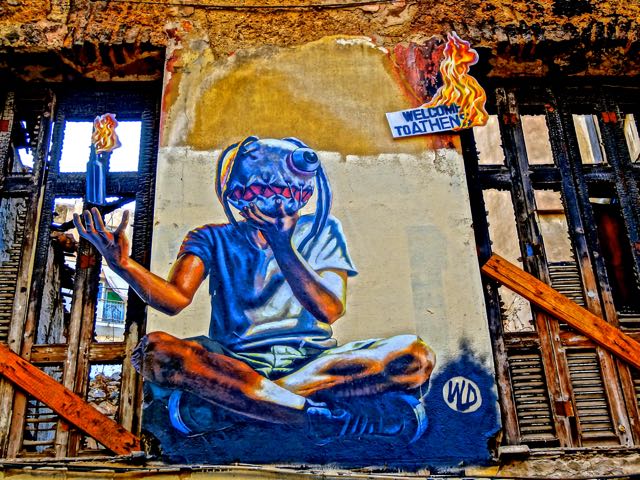 Between the Polytechnic and the University of Athens on Akadamias Street is an area of esoteric bookshops, guitar stores, restaurants, bars, clubs, cafes, fast-food, CD and vinyl shops, and revolution called Exarchia. This is an area where the police do not go, though it is not dangerous for normal
people, just for the police. On Emanual Benaki street there is an excellent little ouzeri called Lesvos, which as the name suggests, features food and ouzo from the island of Lesvos and a great place to eat and hang-out day or night. Continue up Benaki and you will pass some heavy metal CD and vinyl shops and a number of cafes that finally lead you to within a block of Exarchia square. Though Exarchia gets a bad name,
since this is where the so-called 'anarchists' battle the police at night, and the US Embassy has gone so far as to warn Americans not to go there, if you are of college-age you might take this as an invitation. Between the Polytechnic and the University of Athens on Akadamias Street is an area of esoteric bookshops, guitar stores, restaurants, bars, clubs, cafes, fast-food, CD and vinyl shops, and revolution called Exarchia. This is an area where the police do not go, though it is not dangerous for normal
people, just for the police. On Emanual Benaki street there is an excellent little ouzeri called Lesvos, which as the name suggests, features food and ouzo from the island of Lesvos and a great place to eat and hang-out day or night. Continue up Benaki and you will pass some heavy metal CD and vinyl shops and a number of cafes that finally lead you to within a block of Exarchia square. Though Exarchia gets a bad name,
since this is where the so-called 'anarchists' battle the police at night, and the US Embassy has gone so far as to warn Americans not to go there, if you are of college-age you might take this as an invitation.
|
|
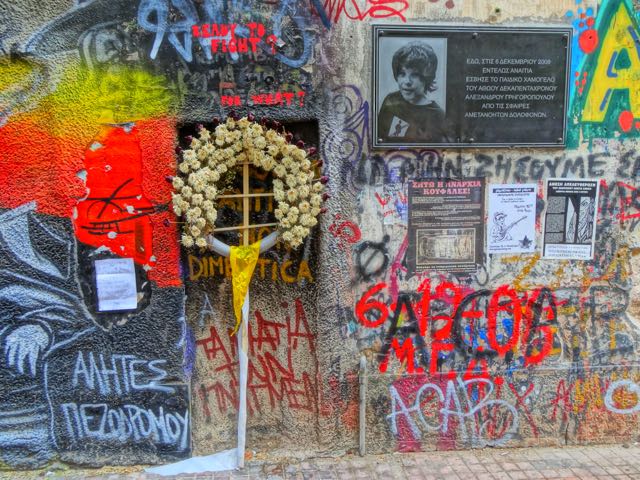 Those who do visit Exarchia in the daytime will find a neighborhood full of hip cafes, restaurants, galleries, computer, music and art stores, lots of graffiti, clubs, bars and the kind of stuff you will find in any urban University area. Many young people visit the Shrine to Alexander Grigoropoulou,
the boy who was shot by the police which set off the riots of December 2008, on the corner of Mesolongiou, now unofficially renamed Alexander Grigoropoulou Street and Tzabella street. The whole area is pretty remarkable as a no-frills center of counter culture. If you are over 30 and come from a small town and are exploring Athens with your family I would probably tell you to steer clear. But those of student age and mentality who want to see what New York's East Village was like before the yuppies took
it over, and who find the Plaka boring should find Exarchia kind of cool in the day and scary but thrilling at night with its bars, clubs, restaurants and often the smell of tear gas as cops in riot gear get into position to engage the enemy, which hopefully they won't think is you. See my Exarchia page Those who do visit Exarchia in the daytime will find a neighborhood full of hip cafes, restaurants, galleries, computer, music and art stores, lots of graffiti, clubs, bars and the kind of stuff you will find in any urban University area. Many young people visit the Shrine to Alexander Grigoropoulou,
the boy who was shot by the police which set off the riots of December 2008, on the corner of Mesolongiou, now unofficially renamed Alexander Grigoropoulou Street and Tzabella street. The whole area is pretty remarkable as a no-frills center of counter culture. If you are over 30 and come from a small town and are exploring Athens with your family I would probably tell you to steer clear. But those of student age and mentality who want to see what New York's East Village was like before the yuppies took
it over, and who find the Plaka boring should find Exarchia kind of cool in the day and scary but thrilling at night with its bars, clubs, restaurants and often the smell of tear gas as cops in riot gear get into position to engage the enemy, which hopefully they won't think is you. See my Exarchia page
Hotels in Exarchia
You will probably want to be of college age, an artist, a revolutionary, a rock musician or a writer to stay in this area but there are several good hotels and because most tourists prefer to be where they feel 'safe' there are some bargains here. The Museum
Hotel, is a former Best Western which implies a certain high standard and is right behind the National Archaeological Museum. Despite its reputation as a hotbed of anarchist activity, Exarchia is really just an urban college town on acid and it is a real neighborhood where people watch out for each other and I would stay here over Metaxourgio or Larissa train station if those are your only options
due to finances. The 3-star Exarchia Hotel has singles, doubles, triples and quads and is located right in Exarchia Square, the wildest in Athens. The 4-star Melia Athens Hotel is located between Exarchia
and Omonia Square and the Dryades Hotel is on Strofi Hill, the highest part of Exarchia. You can find other places to stay in and around Exarchia on Matt's Budget Hotel page
|
National Museum of Archaeology
|
|
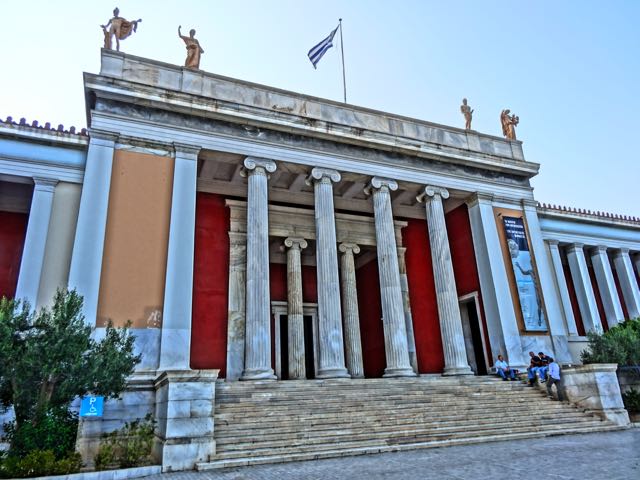 If you
are not adventurous enough to visit Exarchia you can continue walking
up 28th of October street and you will come to the
National Archaeology Museum one of the best archaeology museums in the world. A visit here is a must and you need at least two or three hours to see it as it contains just about every important ancient piece that you have seen in your ancient history and art textbooks and some pieces that you may have never seen that I guarantee will impress you. There are also thousands and thousands of pieces packed up in crates because not
only do they not have space for them, they don't have enough archaeologists or enough time to go through them all. If you don't hire a guide at least get the guidebook so you will know what you are looking at. Probably the most popular piece in the museum
is the 2000 year old computer that was found in the sea off the island of Kythira and is known by anyone who has read the works of Erich Von Daniken though recently has appeared in more mainstream magazines and even the History Channel and National Geographic. While you are in the area you should also stop at the Hellenic Motor Museum and see the amazing collection of cars. If you
are not adventurous enough to visit Exarchia you can continue walking
up 28th of October street and you will come to the
National Archaeology Museum one of the best archaeology museums in the world. A visit here is a must and you need at least two or three hours to see it as it contains just about every important ancient piece that you have seen in your ancient history and art textbooks and some pieces that you may have never seen that I guarantee will impress you. There are also thousands and thousands of pieces packed up in crates because not
only do they not have space for them, they don't have enough archaeologists or enough time to go through them all. If you don't hire a guide at least get the guidebook so you will know what you are looking at. Probably the most popular piece in the museum
is the 2000 year old computer that was found in the sea off the island of Kythira and is known by anyone who has read the works of Erich Von Daniken though recently has appeared in more mainstream magazines and even the History Channel and National Geographic. While you are in the area you should also stop at the Hellenic Motor Museum and see the amazing collection of cars.
|
Beyond the Museum: Pedion Areos and Kypseli
|
|
 Beyond the
museum is Pedion Areos, the largest park in Athens and also contains the law courts, a place you don't want to end up in. Pedeon Areos is the former military parade grounds and the largest park in Athens and features a massive statue of King Constantine, perhaps Greece's worst king, whose military ineptitude enabled the country to lose all that it had gained in Asia Minor through the diplomacy of Eleftherios Venizelos. Recently the park underwent an historic renovation that
cost millions of euros and should have made it the most beautiful park in Athens. But the park never quite looked like it was supposed to with meandering rivers lined with flowers and crossed by footbridges. They say they ran out of money or out of water or they just gave up and hoped nobody would notice. In 2015 it became a popular place for refugees from the Middle East to campy on their way to Europe. You can still walk down the wide tree-shaded avenues and see the old men who play tablis (backgammon) and
cards here like it is a big outdoor cafeneon but at night it is an area to be avoided, not because of the refugees but because the drug addicts like the park because it gives them privacy. Eventually it should be nice again. Beyond the
museum is Pedion Areos, the largest park in Athens and also contains the law courts, a place you don't want to end up in. Pedeon Areos is the former military parade grounds and the largest park in Athens and features a massive statue of King Constantine, perhaps Greece's worst king, whose military ineptitude enabled the country to lose all that it had gained in Asia Minor through the diplomacy of Eleftherios Venizelos. Recently the park underwent an historic renovation that
cost millions of euros and should have made it the most beautiful park in Athens. But the park never quite looked like it was supposed to with meandering rivers lined with flowers and crossed by footbridges. They say they ran out of money or out of water or they just gave up and hoped nobody would notice. In 2015 it became a popular place for refugees from the Middle East to campy on their way to Europe. You can still walk down the wide tree-shaded avenues and see the old men who play tablis (backgammon) and
cards here like it is a big outdoor cafeneon but at night it is an area to be avoided, not because of the refugees but because the drug addicts like the park because it gives them privacy. Eventually it should be nice again.
The 5-Star Park Hotel on Alexandras Avenue overlooks the park and is one of those hotels that you can find bargain rates because of its less than stellar location. But if you can stay in a 5-star hotel for 120 euros you should go for it since you can walk on the main avenues all the way to Syntagma Square. On the corner of Alexandras Avenue and 28th of October-Patission
Street is the tiny Egypt Square where you can catch the buses to Rafina, Lavrion, Marathon, Oropos (for the ferry to Evia) and Sounion.
|
|
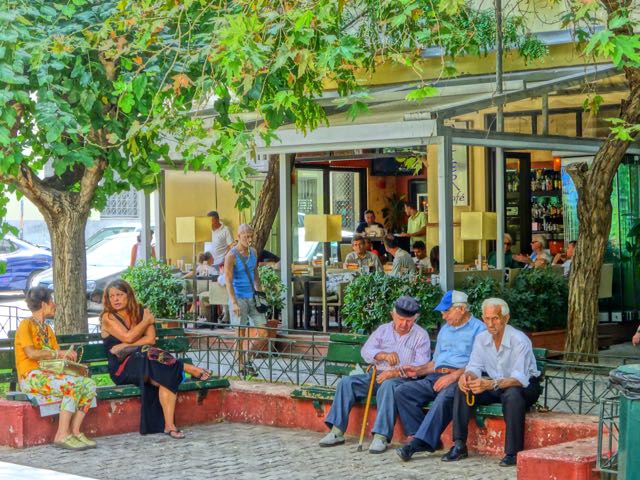 Beyond that is the neighborhood of Kypseli which is one of
my favorite areas. Kypseli, despite being one of
the most densely populated neighborhoods in the
world has Fokoinios Negri, a long avenue that was
turned into a park and bordered by cafes and
restaurants including a few of my favorites. This is an area that I know very well because we have an apartment here. It used to be a wealthy neighborhood, sort of like Kolonaki but with houses since it was on the edge of the city. (Kypseli means beehive). Then in the sixties like many parts of Athens, home owners were convinced by developers to give up their house for demolition in exchange for a few apartments in the 5 or 6 story apartment building that would take its place. In a feeding frenzy
of greed they knocked down hundreds of beautiful old houses, even the house of Konstantine Kanaris, a national hero, which would be like knocking down Abraham Lincoln's house. Now Kypseli is a mixed area of old and young Greeks, Albanians and other immigrants as well as artists and actors, since it is sort of the Off-Broadway of Athens with lots of small theaters. To get to Kypseli keep walking up Pattission Street, past the Bowling Alley and turn right on Agia Melitiou and to your left Fokionos Negri begins.
See
my Guide to Kypseli Beyond that is the neighborhood of Kypseli which is one of
my favorite areas. Kypseli, despite being one of
the most densely populated neighborhoods in the
world has Fokoinios Negri, a long avenue that was
turned into a park and bordered by cafes and
restaurants including a few of my favorites. This is an area that I know very well because we have an apartment here. It used to be a wealthy neighborhood, sort of like Kolonaki but with houses since it was on the edge of the city. (Kypseli means beehive). Then in the sixties like many parts of Athens, home owners were convinced by developers to give up their house for demolition in exchange for a few apartments in the 5 or 6 story apartment building that would take its place. In a feeding frenzy
of greed they knocked down hundreds of beautiful old houses, even the house of Konstantine Kanaris, a national hero, which would be like knocking down Abraham Lincoln's house. Now Kypseli is a mixed area of old and young Greeks, Albanians and other immigrants as well as artists and actors, since it is sort of the Off-Broadway of Athens with lots of small theaters. To get to Kypseli keep walking up Pattission Street, past the Bowling Alley and turn right on Agia Melitiou and to your left Fokionos Negri begins.
See
my Guide to Kypseli
|
From Omonia to Syntagma Square
|
|
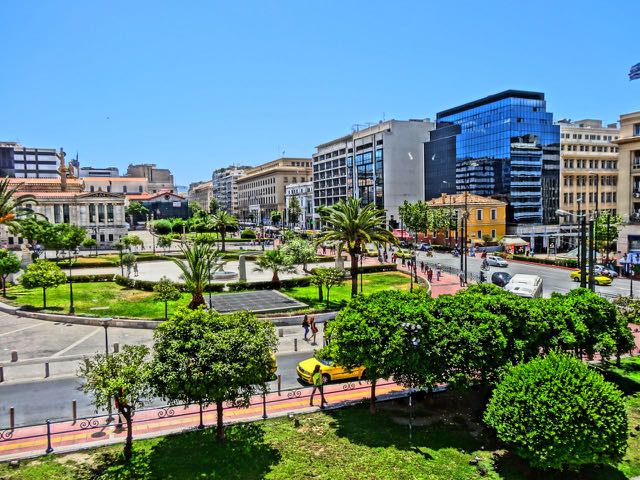 Panepistimiou Street is one of two main avenues that connect Omonia Square to Syntagma Square. (Stadiou Street is he other) It means University Street, since this is where the University of Athens is, but it is also called Eleftherios Venizelos Street after the man
who was probably the Abraham Lincoln of Greece. Like
Lincoln, the way you feel about him depends on where you stand socially and politically or even what part of the country you come from. Some love him and some hate him, even today. His house is still on Venizelos Street and the only reason he is not buried in Athens rather than his home island of Crete is because the government was afraid there would be riots when they brought his body back from Paris in 1932, where he was living in exile. (You can read more about him at History
of Greece: Venizelos). Panepistimiou Street is one of two main avenues that connect Omonia Square to Syntagma Square. (Stadiou Street is he other) It means University Street, since this is where the University of Athens is, but it is also called Eleftherios Venizelos Street after the man
who was probably the Abraham Lincoln of Greece. Like
Lincoln, the way you feel about him depends on where you stand socially and politically or even what part of the country you come from. Some love him and some hate him, even today. His house is still on Venizelos Street and the only reason he is not buried in Athens rather than his home island of Crete is because the government was afraid there would be riots when they brought his body back from Paris in 1932, where he was living in exile. (You can read more about him at History
of Greece: Venizelos).
|
|
 Panepistimiou or Venizelos Street, whichever you prefer, was at one time a dry riverbed that they
finally covered up in 1858. The river bed is still underneath in a tunnel and in fact the metro tunnel is underneath that. In 1867 the State Treasury which was located here was robbed by a team of thieves who entered the tunnel near Omonia Square. To find the exact spot to break into the building they found a merchant who was having trouble getting
his money from the treasury, and paid him in cash for the check. Then one of the robbers went into the building and when told he could not cash the check he threw a tantrum and banged his cane on the floor to let the others know the location. They waited until the building was closed and broke through the wooden floor. But they were caught the next day. Panepistimiou or Venizelos Street, whichever you prefer, was at one time a dry riverbed that they
finally covered up in 1858. The river bed is still underneath in a tunnel and in fact the metro tunnel is underneath that. In 1867 the State Treasury which was located here was robbed by a team of thieves who entered the tunnel near Omonia Square. To find the exact spot to break into the building they found a merchant who was having trouble getting
his money from the treasury, and paid him in cash for the check. Then one of the robbers went into the building and when told he could not cash the check he threw a tantrum and banged his cane on the floor to let the others know the location. They waited until the building was closed and broke through the wooden floor. But they were caught the next day.
|
|
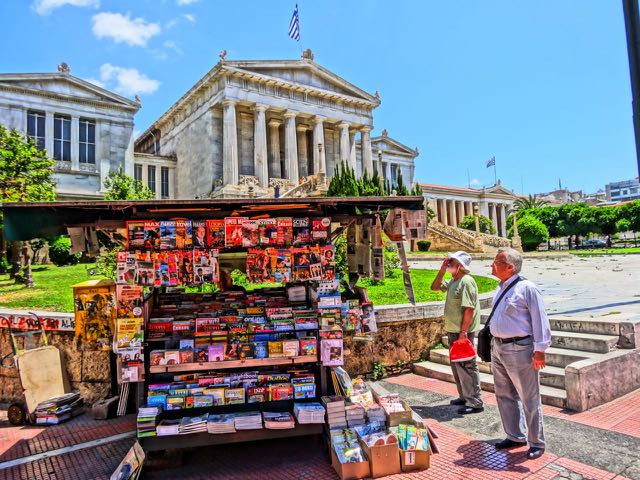 If you walk back up Panepistimiou- E Venizelos Street from Omonia you will
pass the University of Athens on your left. If you
want to see what Ancient Athens looked like in
it's golden age these buildings will give you a
good idea. Go inside and see the library (photo). Just beyond is the Roman Catholic Church of Saint Denis. Across from the University in the concrete park-like
area called Platia Korai and the Panepistimiou metro station. If you walk through Platia Korai and cross Stadiou Street you are in Klathmanos Square which is now known for the electronic shops and the Byzantine church of Agio Theodori. In the mid 1800s the houses around the square were rented to civil servants. When each political party replaced the previous, the civil servants were also replaced and sat in the cafes on the square lamenting their jobless future.
The square
became known as 'the Weeping Square" (Klathmanos). In the beautiful neo-classical building on the square, the first residence of Greece's first royal couple and known as 'the old palace', is the Museum of the City of Athens which presents the history of the city from the end of the middle ages to the present. In the center of the square is a giant modern sculpture that signifies I don't know what but is impressive nonetheless. There is a cafe in the square and behind it, by the church of
Agio Theodori there are some cool little cafes and bars that are fun at night. If you walk back up Panepistimiou- E Venizelos Street from Omonia you will
pass the University of Athens on your left. If you
want to see what Ancient Athens looked like in
it's golden age these buildings will give you a
good idea. Go inside and see the library (photo). Just beyond is the Roman Catholic Church of Saint Denis. Across from the University in the concrete park-like
area called Platia Korai and the Panepistimiou metro station. If you walk through Platia Korai and cross Stadiou Street you are in Klathmanos Square which is now known for the electronic shops and the Byzantine church of Agio Theodori. In the mid 1800s the houses around the square were rented to civil servants. When each political party replaced the previous, the civil servants were also replaced and sat in the cafes on the square lamenting their jobless future.
The square
became known as 'the Weeping Square" (Klathmanos). In the beautiful neo-classical building on the square, the first residence of Greece's first royal couple and known as 'the old palace', is the Museum of the City of Athens which presents the history of the city from the end of the middle ages to the present. In the center of the square is a giant modern sculpture that signifies I don't know what but is impressive nonetheless. There is a cafe in the square and behind it, by the church of
Agio Theodori there are some cool little cafes and bars that are fun at night.
|
|
 Panepistimiou- E Venizelos Street is known for its arcades, covered streets, like the Arsakeio Arcade and the Printers Arcade, linking Panepistimiou and Stadiou streets which used to be among the most elegant shopping areas in Athens. In the Stoa Pezmazoglou at 39 Panepistimiou, right across
from the University there is a very interesting little music shop called Nikos Xilouris. Xilouris is to Cretan music as Hank Williams is to country music and this tiny store is full of his CDs, DVDs, books and memorabilia plus music by other Cretan, Rembetika and Laika musicians. The shop is owned by his son Giorgos Xilouris
and is a great place to buy Greek music or just to stop in and say hello if you are a Xilouris fan. Panepistimiou- E Venizelos Street is known for its arcades, covered streets, like the Arsakeio Arcade and the Printers Arcade, linking Panepistimiou and Stadiou streets which used to be among the most elegant shopping areas in Athens. In the Stoa Pezmazoglou at 39 Panepistimiou, right across
from the University there is a very interesting little music shop called Nikos Xilouris. Xilouris is to Cretan music as Hank Williams is to country music and this tiny store is full of his CDs, DVDs, books and memorabilia plus music by other Cretan, Rembetika and Laika musicians. The shop is owned by his son Giorgos Xilouris
and is a great place to buy Greek music or just to stop in and say hello if you are a Xilouris fan.
|
|
 If you return to Panapistimiou Street and go right towards Syntagma further on is the Iliou Melathron, the Palace of Ilion and Home of Henrich Schlieman on your left. The Schlieman Mansion is considered to
be the finest work of the architect Ernst Ziller, built between 1870 and 1881 in a style that combines neo-classical and renaissance architecture and
now houses the Numismatic Museum. For those who
don't know, Schlieman was the German archaeologist-adventurer
who discovered Troy and Mycenae and
Numismatic means coins.
The Numismatic museum is considered one of the best in the world with 600,000 coins housed in one of the most beautiful buildings of Athens decorated by some spectacular wall paintings of the Pompeian style as well as geometric style floor mosaics. Across the street the famous Zonars Cafe is on the corner of Voukourestiou in the same building as the enormous Attica department store. If you take a left on Voukourestiou Street and cross Panapistimiou-Venizelou
you can go straight up to Kolonaki and Mount Lycabettos. If
you go up Omirou street you will at #36 is Cafe Boheme, an excellent bistro-style restaurant open for lunch and dinner which on weekends and some weeknights becomes the biggest party in the world's smallest club. They have live music on Wednesdays too. If you return to Panapistimiou Street and go right towards Syntagma further on is the Iliou Melathron, the Palace of Ilion and Home of Henrich Schlieman on your left. The Schlieman Mansion is considered to
be the finest work of the architect Ernst Ziller, built between 1870 and 1881 in a style that combines neo-classical and renaissance architecture and
now houses the Numismatic Museum. For those who
don't know, Schlieman was the German archaeologist-adventurer
who discovered Troy and Mycenae and
Numismatic means coins.
The Numismatic museum is considered one of the best in the world with 600,000 coins housed in one of the most beautiful buildings of Athens decorated by some spectacular wall paintings of the Pompeian style as well as geometric style floor mosaics. Across the street the famous Zonars Cafe is on the corner of Voukourestiou in the same building as the enormous Attica department store. If you take a left on Voukourestiou Street and cross Panapistimiou-Venizelou
you can go straight up to Kolonaki and Mount Lycabettos. If
you go up Omirou street you will at #36 is Cafe Boheme, an excellent bistro-style restaurant open for lunch and dinner which on weekends and some weeknights becomes the biggest party in the world's smallest club. They have live music on Wednesdays too.
|
|
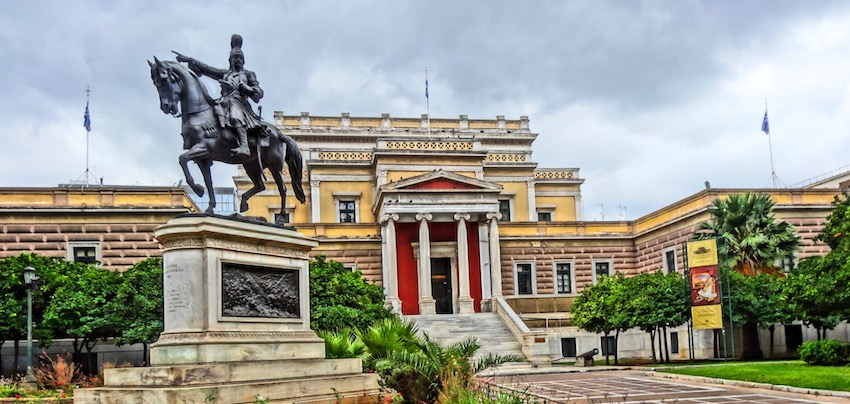 If you cut over from Panapistimiou-Venizelou to Stadiou street you will come to the Virgin Music superstore and Kolokotronis Square with its statue of Greece's revolutionary hero on horseback outside the Old Parliament Building which is now the National Historical Museum. Designed by the French
architect
Boulanger and
completed in 1875 the museum covers Greek history from the fall of Constantinople in 1453 to World War 2 and contains historical paintings, furniture,
traditional costumes, and weapons that belonged to some of your favorite heroes of modern Greek history and definitely worth a visit. In 1905 Prime Minister Delyianis was stabbed fatally in the stomach on the steps of this building by an assassin who was upset at the closing of the casinos of Athens. Behind the museum is an outdoor cafe and a small stoa with a couple bars that are hopping at night. If you wander around the back streets you will eventually find the Square of Agios Giorgos which has a couple cafes
and an ouzeri. But if you follow where the statue of Kolokotronis is pointing you will find one of the best ouzeris in Athens. If you cut over from Panapistimiou-Venizelou to Stadiou street you will come to the Virgin Music superstore and Kolokotronis Square with its statue of Greece's revolutionary hero on horseback outside the Old Parliament Building which is now the National Historical Museum. Designed by the French
architect
Boulanger and
completed in 1875 the museum covers Greek history from the fall of Constantinople in 1453 to World War 2 and contains historical paintings, furniture,
traditional costumes, and weapons that belonged to some of your favorite heroes of modern Greek history and definitely worth a visit. In 1905 Prime Minister Delyianis was stabbed fatally in the stomach on the steps of this building by an assassin who was upset at the closing of the casinos of Athens. Behind the museum is an outdoor cafe and a small stoa with a couple bars that are hopping at night. If you wander around the back streets you will eventually find the Square of Agios Giorgos which has a couple cafes
and an ouzeri. But if you follow where the statue of Kolokotronis is pointing you will find one of the best ouzeris in Athens.
|
|
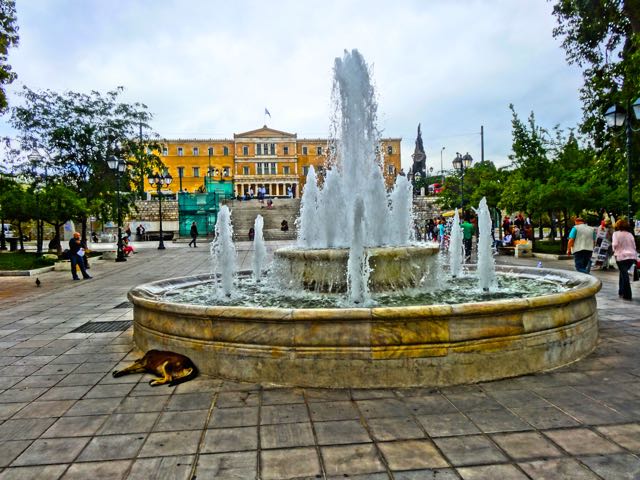 If you continue up Panapistimiou or Stadiou street you will find yourself at Syntagma Square either at the top where the Parliament is or at the bottom where Ermou Street, Athens main shopping district, begins. To get back to Athinas Street where this tour began, just
turn right down Karagiorgis Servias street until you can't go any further. The street will change names several times but as long as you don't change streets you will get there. Along the way on the corner of Voulis you will see a plaque on the wall across from the Hotel Astor, in memorial to Athanasios Axarlian, a 22 year old student who
was killed
when a rocket fired by November 17th glanced off the limo of Finance Minister Ioannis Palaiokrassas in 1992. Axarlian had come to Athens to escape the war in Yugoslavia where he was a student. If you go left on Voulis Street you will come to the Plaka. If you go right on Voulis Street you will come to Ariston, my favorite tiropita (cheesepie) shop and if you turn down Lekka, right near the Hotel
Achileous is one of my favorite little restaurants called Triantafillo tis Nostimias at # 22. If you continue up Panapistimiou or Stadiou street you will find yourself at Syntagma Square either at the top where the Parliament is or at the bottom where Ermou Street, Athens main shopping district, begins. To get back to Athinas Street where this tour began, just
turn right down Karagiorgis Servias street until you can't go any further. The street will change names several times but as long as you don't change streets you will get there. Along the way on the corner of Voulis you will see a plaque on the wall across from the Hotel Astor, in memorial to Athanasios Axarlian, a 22 year old student who
was killed
when a rocket fired by November 17th glanced off the limo of Finance Minister Ioannis Palaiokrassas in 1992. Axarlian had come to Athens to escape the war in Yugoslavia where he was a student. If you go left on Voulis Street you will come to the Plaka. If you go right on Voulis Street you will come to Ariston, my favorite tiropita (cheesepie) shop and if you turn down Lekka, right near the Hotel
Achileous is one of my favorite little restaurants called Triantafillo tis Nostimias at # 22.
|
Hotels Between Omonia and Syntagma
The recently renovated Hotel Titania, on Panapistimiou, near the University of Athens has an Olive Garden Restaurant on the roof with a view of the Acropolis and is one of the nicest hotels in the area. It has that NYC mid-town
feel to it, especially when you walk out the front door. Otherwise it is slim pickings til you get to Syntagma Square.
|
|

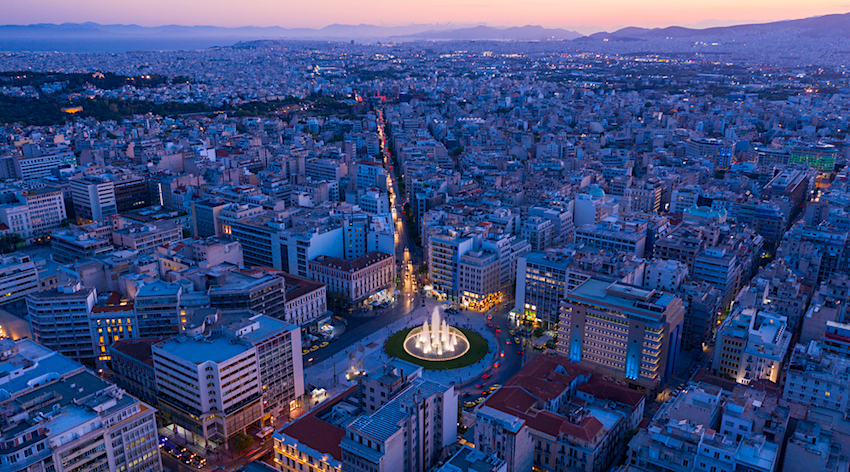

 Beyond the
Beyond the
 In the nineties the square unfortunately
became a hangout for drug dealers and junkies
at night and the area got a bad reputation. But it was always perfectly safe by day
since it is in the primary shopping area of Athens
and now that they have moved all the undesirables to
the area by the train station Platia Kotzia can be visited at any time. Be sure
to check out the sculptures on display here and
the pet store with the exotic parrots and toucans.
There are a couple great cafes on the square,
especially the one next to the pet store where you
can buy a cheese pie and spend hours being
entertained by the pigeons who fight each other
for it. Across the square from the pet store are a
couple classic cafeneons just on the other side of
the ruins. The impressive National Bank of Greece on the bottom (or maybe its the top) of the square is on AAeolou Street, one of Athens popular pedestrian shopping streets, which leads you right back past the
In the nineties the square unfortunately
became a hangout for drug dealers and junkies
at night and the area got a bad reputation. But it was always perfectly safe by day
since it is in the primary shopping area of Athens
and now that they have moved all the undesirables to
the area by the train station Platia Kotzia can be visited at any time. Be sure
to check out the sculptures on display here and
the pet store with the exotic parrots and toucans.
There are a couple great cafes on the square,
especially the one next to the pet store where you
can buy a cheese pie and spend hours being
entertained by the pigeons who fight each other
for it. Across the square from the pet store are a
couple classic cafeneons just on the other side of
the ruins. The impressive National Bank of Greece on the bottom (or maybe its the top) of the square is on AAeolou Street, one of Athens popular pedestrian shopping streets, which leads you right back past the  Omonia
square was at one time quite beautiful and a
centerpiece for the city. If you go downstairs
into the metro station you can see old photos of
it in the glory days. When Athens embraced the
automobile, Omonia was one of the major casualties
and the square became less people friendly and
eventually it was not even automobile friendly as
cars converged on it from all directions. They
have been trying to recapture the bygone days and
have rebuilt the square several times in the last
few years either to 'get it right' or to
make sure a construction company owner or
city official does not go to bed hungry. The
Omonia
square was at one time quite beautiful and a
centerpiece for the city. If you go downstairs
into the metro station you can see old photos of
it in the glory days. When Athens embraced the
automobile, Omonia was one of the major casualties
and the square became less people friendly and
eventually it was not even automobile friendly as
cars converged on it from all directions. They
have been trying to recapture the bygone days and
have rebuilt the square several times in the last
few years either to 'get it right' or to
make sure a construction company owner or
city official does not go to bed hungry. The
 You can get a lot of hotel for the money if you want to stay in the triangle between Omonia, Kariaskaki Square and the Larissa Train Station. 4 and 5 star horels can cost what you would pay for a 2 star hotel in the Plaka, though as more tourists choose Greece I am
guessing the prices will rise, if they haven't already. On booking sites some of the hotels lose points because of location but in general they can be well run and clean and just a few steps from the Metaxougeio or Omonia Square Metro. The
You can get a lot of hotel for the money if you want to stay in the triangle between Omonia, Kariaskaki Square and the Larissa Train Station. 4 and 5 star horels can cost what you would pay for a 2 star hotel in the Plaka, though as more tourists choose Greece I am
guessing the prices will rise, if they haven't already. On booking sites some of the hotels lose points because of location but in general they can be well run and clean and just a few steps from the Metaxougeio or Omonia Square Metro. The 
 Between the Polytechnic and the University of Athens on Akadamias Street is an area of esoteric bookshops, guitar stores, restaurants, bars, clubs, cafes, fast-food, CD and vinyl shops, and revolution called Exarchia. This is an area where the police do not go, though it is not dangerous for normal
people, just for the police. On Emanual Benaki street there is an excellent little ouzeri called Lesvos, which as the name suggests, features food and ouzo from the island of Lesvos and a great place to eat and hang-out day or night. Continue up Benaki and you will pass some heavy metal CD and vinyl shops and a number of cafes that finally lead you to within a block of Exarchia square. Though Exarchia gets a bad name,
since this is where the so-called 'anarchists' battle the police at night, and the US Embassy has gone so far as to warn Americans not to go there, if you are of college-age you might take this as an invitation.
Between the Polytechnic and the University of Athens on Akadamias Street is an area of esoteric bookshops, guitar stores, restaurants, bars, clubs, cafes, fast-food, CD and vinyl shops, and revolution called Exarchia. This is an area where the police do not go, though it is not dangerous for normal
people, just for the police. On Emanual Benaki street there is an excellent little ouzeri called Lesvos, which as the name suggests, features food and ouzo from the island of Lesvos and a great place to eat and hang-out day or night. Continue up Benaki and you will pass some heavy metal CD and vinyl shops and a number of cafes that finally lead you to within a block of Exarchia square. Though Exarchia gets a bad name,
since this is where the so-called 'anarchists' battle the police at night, and the US Embassy has gone so far as to warn Americans not to go there, if you are of college-age you might take this as an invitation.  Those who do visit Exarchia in the daytime will find a neighborhood full of hip cafes, restaurants, galleries, computer, music and art stores, lots of graffiti, clubs, bars and the kind of stuff you will find in any urban University area. Many young people visit the Shrine to Alexander Grigoropoulou,
the boy who was shot by the police which set off the riots of December 2008, on the corner of Mesolongiou, now unofficially renamed Alexander Grigoropoulou Street and Tzabella street. The whole area is pretty remarkable as a no-frills center of counter culture. If you are over 30 and come from a small town and are exploring Athens with your family I would probably tell you to steer clear. But those of student age and mentality who want to see what New York's East Village was like before the yuppies took
it over, and who find the Plaka boring should find Exarchia kind of cool in the day and scary but thrilling at night with its bars, clubs, restaurants and often the smell of tear gas as cops in riot gear get into position to engage the enemy, which hopefully they won't think is you.
Those who do visit Exarchia in the daytime will find a neighborhood full of hip cafes, restaurants, galleries, computer, music and art stores, lots of graffiti, clubs, bars and the kind of stuff you will find in any urban University area. Many young people visit the Shrine to Alexander Grigoropoulou,
the boy who was shot by the police which set off the riots of December 2008, on the corner of Mesolongiou, now unofficially renamed Alexander Grigoropoulou Street and Tzabella street. The whole area is pretty remarkable as a no-frills center of counter culture. If you are over 30 and come from a small town and are exploring Athens with your family I would probably tell you to steer clear. But those of student age and mentality who want to see what New York's East Village was like before the yuppies took
it over, and who find the Plaka boring should find Exarchia kind of cool in the day and scary but thrilling at night with its bars, clubs, restaurants and often the smell of tear gas as cops in riot gear get into position to engage the enemy, which hopefully they won't think is you.  If you
are not adventurous enough to visit Exarchia you can continue walking
up 28th of October street and you will come to the
If you
are not adventurous enough to visit Exarchia you can continue walking
up 28th of October street and you will come to the
 Beyond the
museum is Pedion Areos, the largest park in Athens and also contains the law courts, a place you don't want to end up in. Pedeon Areos is the former military parade grounds and the largest park in Athens and features a massive statue of King Constantine, perhaps Greece's worst king, whose military ineptitude enabled the country to lose all that it had gained in Asia Minor through the diplomacy of Eleftherios Venizelos. Recently the park underwent an historic renovation that
cost millions of euros and should have made it the most beautiful park in Athens. But the park never quite looked like it was supposed to with meandering rivers lined with flowers and crossed by footbridges. They say they ran out of money or out of water or they just gave up and hoped nobody would notice. In 2015 it became a popular place for refugees from the Middle East to campy on their way to Europe. You can still walk down the wide tree-shaded avenues and see the old men who play tablis (backgammon) and
cards here like it is a big outdoor cafeneon but at night it is an area to be avoided, not because of the refugees but because the drug addicts like the park because it gives them privacy. Eventually it should be nice again.
Beyond the
museum is Pedion Areos, the largest park in Athens and also contains the law courts, a place you don't want to end up in. Pedeon Areos is the former military parade grounds and the largest park in Athens and features a massive statue of King Constantine, perhaps Greece's worst king, whose military ineptitude enabled the country to lose all that it had gained in Asia Minor through the diplomacy of Eleftherios Venizelos. Recently the park underwent an historic renovation that
cost millions of euros and should have made it the most beautiful park in Athens. But the park never quite looked like it was supposed to with meandering rivers lined with flowers and crossed by footbridges. They say they ran out of money or out of water or they just gave up and hoped nobody would notice. In 2015 it became a popular place for refugees from the Middle East to campy on their way to Europe. You can still walk down the wide tree-shaded avenues and see the old men who play tablis (backgammon) and
cards here like it is a big outdoor cafeneon but at night it is an area to be avoided, not because of the refugees but because the drug addicts like the park because it gives them privacy. Eventually it should be nice again. Beyond that is the neighborhood of
Beyond that is the neighborhood of  Panepistimiou Street is one of two main avenues that connect Omonia Square to Syntagma Square. (Stadiou Street is he other) It means University Street, since this is where the University of Athens is, but it is also called Eleftherios Venizelos Street after the man
who was probably the Abraham Lincoln of Greece. Like
Lincoln, the way you feel about him depends on where you stand socially and politically or even what part of the country you come from. Some love him and some hate him, even today. His house is still on Venizelos Street and the only reason he is not buried in Athens rather than his home island of Crete is because the government was afraid there would be riots when they brought his body back from Paris in 1932, where he was living in exile. (You can read more about him at
Panepistimiou Street is one of two main avenues that connect Omonia Square to Syntagma Square. (Stadiou Street is he other) It means University Street, since this is where the University of Athens is, but it is also called Eleftherios Venizelos Street after the man
who was probably the Abraham Lincoln of Greece. Like
Lincoln, the way you feel about him depends on where you stand socially and politically or even what part of the country you come from. Some love him and some hate him, even today. His house is still on Venizelos Street and the only reason he is not buried in Athens rather than his home island of Crete is because the government was afraid there would be riots when they brought his body back from Paris in 1932, where he was living in exile. (You can read more about him at  Panepistimiou or Venizelos Street, whichever you prefer, was at one time a dry riverbed that they
finally covered up in 1858. The river bed is still underneath in a tunnel and in fact the metro tunnel is underneath that. In 1867 the State Treasury which was located here was robbed by a team of thieves who entered the tunnel near Omonia Square. To find the exact spot to break into the building they found a merchant who was having trouble getting
his money from the treasury, and paid him in cash for the check. Then one of the robbers went into the building and when told he could not cash the check he threw a tantrum and banged his cane on the floor to let the others know the location. They waited until the building was closed and broke through the wooden floor. But they were caught the next day.
Panepistimiou or Venizelos Street, whichever you prefer, was at one time a dry riverbed that they
finally covered up in 1858. The river bed is still underneath in a tunnel and in fact the metro tunnel is underneath that. In 1867 the State Treasury which was located here was robbed by a team of thieves who entered the tunnel near Omonia Square. To find the exact spot to break into the building they found a merchant who was having trouble getting
his money from the treasury, and paid him in cash for the check. Then one of the robbers went into the building and when told he could not cash the check he threw a tantrum and banged his cane on the floor to let the others know the location. They waited until the building was closed and broke through the wooden floor. But they were caught the next day.  If you walk back up Panepistimiou- E Venizelos Street from Omonia you will
pass the University of Athens on your left. If you
want to see what Ancient Athens looked like in
it's golden age these buildings will give you a
good idea. Go inside and see the library (photo). Just beyond is the Roman Catholic Church of Saint Denis. Across from the University in the concrete park-like
area called Platia Korai and the Panepistimiou metro station. If you walk through Platia Korai and cross Stadiou Street you are in Klathmanos Square which is now known for the electronic shops and the Byzantine church of Agio Theodori. In the mid 1800s the houses around the square were rented to civil servants. When each political party replaced the previous, the civil servants were also replaced and sat in the cafes on the square lamenting their jobless future.
The square
became known as 'the Weeping Square" (Klathmanos). In the beautiful neo-classical building on the square, the first residence of Greece's first royal couple and known as 'the old palace', is the Museum of the City of Athens which presents the history of the city from the end of the middle ages to the present. In the center of the square is a giant modern sculpture that signifies I don't know what but is impressive nonetheless. There is a cafe in the square and behind it, by the church of
Agio Theodori there are some cool little cafes and bars that are fun at night.
If you walk back up Panepistimiou- E Venizelos Street from Omonia you will
pass the University of Athens on your left. If you
want to see what Ancient Athens looked like in
it's golden age these buildings will give you a
good idea. Go inside and see the library (photo). Just beyond is the Roman Catholic Church of Saint Denis. Across from the University in the concrete park-like
area called Platia Korai and the Panepistimiou metro station. If you walk through Platia Korai and cross Stadiou Street you are in Klathmanos Square which is now known for the electronic shops and the Byzantine church of Agio Theodori. In the mid 1800s the houses around the square were rented to civil servants. When each political party replaced the previous, the civil servants were also replaced and sat in the cafes on the square lamenting their jobless future.
The square
became known as 'the Weeping Square" (Klathmanos). In the beautiful neo-classical building on the square, the first residence of Greece's first royal couple and known as 'the old palace', is the Museum of the City of Athens which presents the history of the city from the end of the middle ages to the present. In the center of the square is a giant modern sculpture that signifies I don't know what but is impressive nonetheless. There is a cafe in the square and behind it, by the church of
Agio Theodori there are some cool little cafes and bars that are fun at night.  Panepistimiou- E Venizelos Street is known for its arcades, covered streets, like the Arsakeio Arcade and the Printers Arcade, linking Panepistimiou and Stadiou streets which used to be among the most elegant shopping areas in Athens. In the Stoa Pezmazoglou at 39 Panepistimiou, right across
from the University there is a very interesting little music shop called Nikos Xilouris. Xilouris is to Cretan music as Hank Williams is to country music and this tiny store is full of his CDs, DVDs, books and memorabilia plus music by other Cretan, Rembetika and Laika musicians. The shop is owned by his son Giorgos Xilouris
and is a great place to buy Greek music or just to stop in and say hello if you are a Xilouris fan.
Panepistimiou- E Venizelos Street is known for its arcades, covered streets, like the Arsakeio Arcade and the Printers Arcade, linking Panepistimiou and Stadiou streets which used to be among the most elegant shopping areas in Athens. In the Stoa Pezmazoglou at 39 Panepistimiou, right across
from the University there is a very interesting little music shop called Nikos Xilouris. Xilouris is to Cretan music as Hank Williams is to country music and this tiny store is full of his CDs, DVDs, books and memorabilia plus music by other Cretan, Rembetika and Laika musicians. The shop is owned by his son Giorgos Xilouris
and is a great place to buy Greek music or just to stop in and say hello if you are a Xilouris fan. If you return to Panapistimiou Street and go right towards Syntagma further on is the Iliou Melathron, the Palace of Ilion and Home of Henrich Schlieman on your left. The Schlieman Mansion is considered to
be the finest work of the architect Ernst Ziller, built between 1870 and 1881 in a style that combines neo-classical and renaissance architecture and
now houses the Numismatic Museum. For those who
don't know, Schlieman was the German archaeologist-adventurer
who discovered Troy and Mycenae and
Numismatic means coins.
The Numismatic museum is considered one of the best in the world with 600,000 coins housed in one of the most beautiful buildings of Athens decorated by some spectacular wall paintings of the Pompeian style as well as geometric style floor mosaics. Across the street the famous Zonars Cafe is on the corner of Voukourestiou in the same building as the enormous Attica department store. If you take a left on Voukourestiou Street and cross Panapistimiou-Venizelou
you can go straight up to
If you return to Panapistimiou Street and go right towards Syntagma further on is the Iliou Melathron, the Palace of Ilion and Home of Henrich Schlieman on your left. The Schlieman Mansion is considered to
be the finest work of the architect Ernst Ziller, built between 1870 and 1881 in a style that combines neo-classical and renaissance architecture and
now houses the Numismatic Museum. For those who
don't know, Schlieman was the German archaeologist-adventurer
who discovered Troy and Mycenae and
Numismatic means coins.
The Numismatic museum is considered one of the best in the world with 600,000 coins housed in one of the most beautiful buildings of Athens decorated by some spectacular wall paintings of the Pompeian style as well as geometric style floor mosaics. Across the street the famous Zonars Cafe is on the corner of Voukourestiou in the same building as the enormous Attica department store. If you take a left on Voukourestiou Street and cross Panapistimiou-Venizelou
you can go straight up to  If you cut over from Panapistimiou-Venizelou to Stadiou street you will come to the Virgin Music superstore and Kolokotronis Square with its statue of Greece's revolutionary hero on horseback outside the Old Parliament Building which is now the National Historical Museum. Designed by the French
architect
Boulanger and
completed in 1875 the museum covers Greek history from the fall of Constantinople in 1453 to World War 2 and contains historical paintings, furniture,
traditional costumes, and weapons that belonged to some of your favorite heroes of modern Greek history and definitely worth a visit. In 1905 Prime Minister Delyianis was stabbed fatally in the stomach on the steps of this building by an assassin who was upset at the closing of the casinos of Athens. Behind the museum is an outdoor cafe and a small stoa with a couple bars that are hopping at night. If you wander around the back streets you will eventually find the Square of Agios Giorgos which has a couple cafes
and an ouzeri. But if you follow where the statue of Kolokotronis is pointing you will find one of the best ouzeris in Athens.
If you cut over from Panapistimiou-Venizelou to Stadiou street you will come to the Virgin Music superstore and Kolokotronis Square with its statue of Greece's revolutionary hero on horseback outside the Old Parliament Building which is now the National Historical Museum. Designed by the French
architect
Boulanger and
completed in 1875 the museum covers Greek history from the fall of Constantinople in 1453 to World War 2 and contains historical paintings, furniture,
traditional costumes, and weapons that belonged to some of your favorite heroes of modern Greek history and definitely worth a visit. In 1905 Prime Minister Delyianis was stabbed fatally in the stomach on the steps of this building by an assassin who was upset at the closing of the casinos of Athens. Behind the museum is an outdoor cafe and a small stoa with a couple bars that are hopping at night. If you wander around the back streets you will eventually find the Square of Agios Giorgos which has a couple cafes
and an ouzeri. But if you follow where the statue of Kolokotronis is pointing you will find one of the best ouzeris in Athens. If you continue up Panapistimiou or Stadiou street you will find yourself at
If you continue up Panapistimiou or Stadiou street you will find yourself at 

